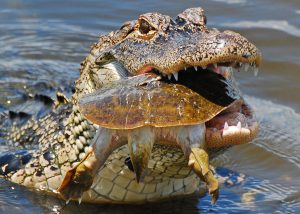Everglades Food Web
 The Florida Everglades is not only the perfect place to get in touch with your wild side during your time in Fort Myers Beach or Southwest Florida, it is also an intricate landscape that plays host to the ecosystem that allows our destination to be one of a kind. Yes, alligators and airboats are half of the fun, but the Florida Everglades is on its own, a world wonder that only exists in one place… right here! To understand the Everglades is to understand the natural systems that keep this region, including its plants and animals, vital and functioning—and the number one measure of health for the river of grass is, you guessed it, food!
The Florida Everglades is not only the perfect place to get in touch with your wild side during your time in Fort Myers Beach or Southwest Florida, it is also an intricate landscape that plays host to the ecosystem that allows our destination to be one of a kind. Yes, alligators and airboats are half of the fun, but the Florida Everglades is on its own, a world wonder that only exists in one place… right here! To understand the Everglades is to understand the natural systems that keep this region, including its plants and animals, vital and functioning—and the number one measure of health for the river of grass is, you guessed it, food!
The Everglades food web is an intricate, balanced relationship that allows every living thing in the area to thrive. As with all life on earth, the everglades food web begins with the sun. Year-round sunshine provides optimum conditions for all the creatures and plants that call the everglades home to remain healthy and happy. The sun provides all our local plant life, such as the butterfly orchid and the bladderwort plant to thrive. Sun also keeps the sawgrass, mangroves, and cypress trees alive, which in turn provide shelter for numerous animals both big and small. When the plant environment is strong, all the other wildlife is provided a sturdy foundation to live and reproduce upon.
Animals as small as our local mosquito, to the eastern mud turtle, in the right conditions lay their eggs and provide a healthy environment to enter. When the lower levels of the food chain thrive, the upper levels can also sustain their populations and continue the Everglades food web.
When mosquitos thrive, the creatures that feed on mosquitos thrive! Frogs like the southern leopard frog and fish like the grass carp and even small birds can sustain themselves and their newborns when they have access to mosquitos they can feed on. Herbivores, like the eastern mud turtle remain healthy for reproduction when aquatic and terrestrial plants thrive.
As you may expect, when these animals who hold a place in the middle level of the everglades food web are plentiful, they eventually become food for those who hold placement in the upper level of the food web. Mammals like raccoons, as well as large wading birds like the great blue heron can dine on these lower level everglades food web species, which will in turn sustain their populations. At the top of the food chain, you guessed it, alligators, panthers, and bears (some of the most endangered species in the Everglades) can sustain their populations and complete the natural food web of the Everglades.
Like every other ecosystem in the world, The Everglades is the result of a delicate balance of a variety of species all thriving in one area—South Florida. We must do all we can to preserve this relationship to ensure the survival of all our native species for years to come.
The best part? See the Everglades food web in action on our adventure tour!


